We all may hear about inswinging crosses and outswinging corners, knowing that they have become important in each corner routine, or even any set-piece routine, but how and why did it become a big issue?!
There are many tactical differences between them, like the possibility of getting the first touch and the possibility of scoring goals. Still, in this tactical analysis, we will specifically talk about the reason for changing the defending positions according to it and how it could cause a gap on the near post in the case of outswinging crosses.
Inswinging crosses lead more to the near post than outswinging ones, which usually land between the six-yard and the penalty spot or the further area in front of the far post which we will call, in this article, the far area or the far-post area. Hence, defending teams take care of these areas, making the line for the zonal and hybrid system more inclined outwards and also changing the positions of some players. Still, a few out-swinging crosses land on the corner of the six-yard on the near post, which could be surprising for the defending system, and that is what we will talk about in this set-piece analysis.
Distance between players
There are many variables in the two defending schemes against inswinging and outswinging corners that the same team implements, which could cause this problem, but in principle, the attacking team should have an excellent outswinger to deliver the ball around the near corner of the six-yard, as we will explain.
The first variable we will talk about is the distance between players on the near post, so you can note that S.S. Lazio defends by the same numerical scheme against inswinging and outswinging corners in the two photos below in the same match against Juventus in Serie A.
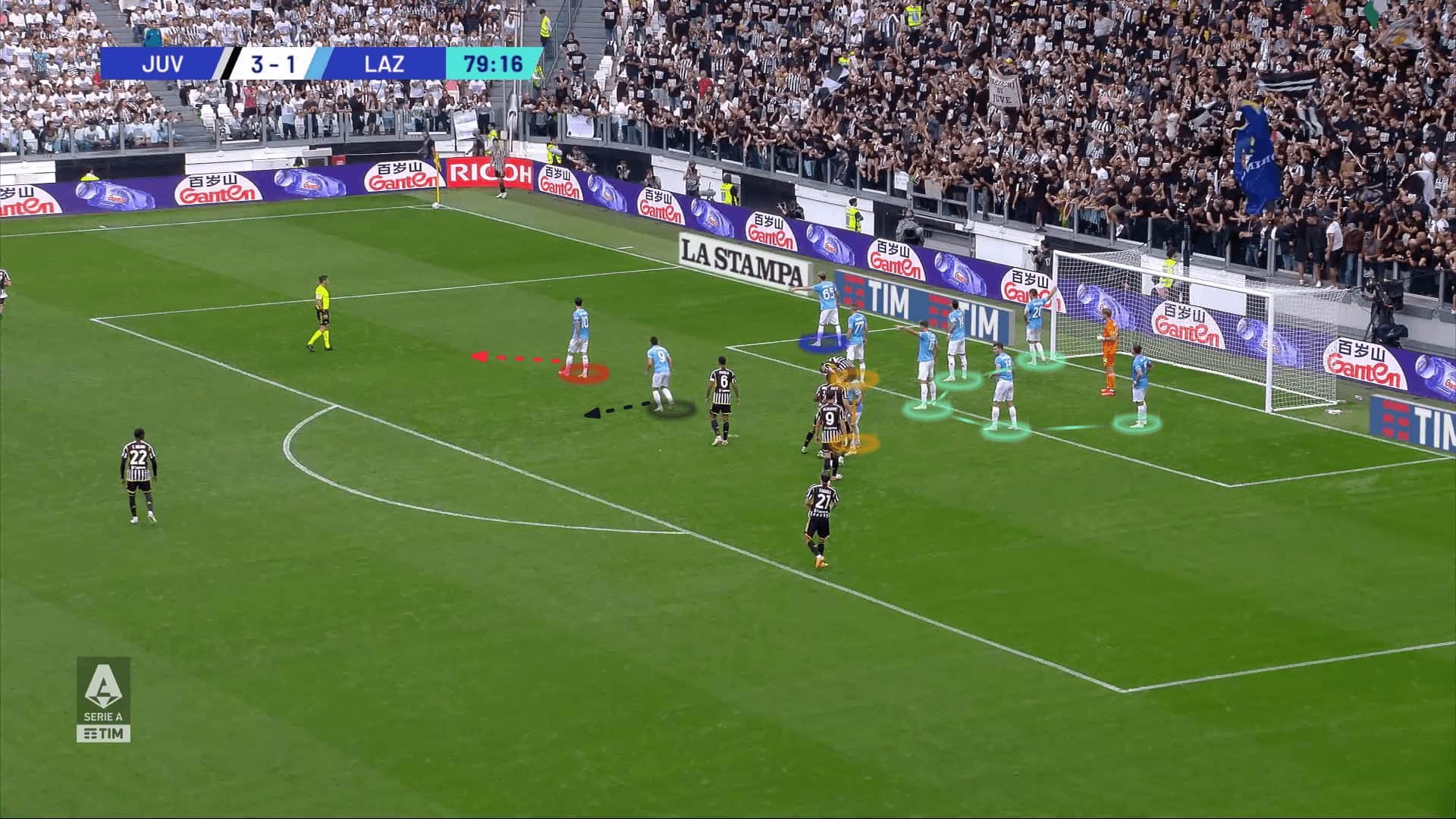
They defended by five zonal defenders, a defender in front of them to get the first touch, two second-zone defenders, a short-area defender and a defender for the rebound in the two cases, but you can note the considerable distance between two players, the first-touch defender and the first second-zone defender, on the near post in the second photo.
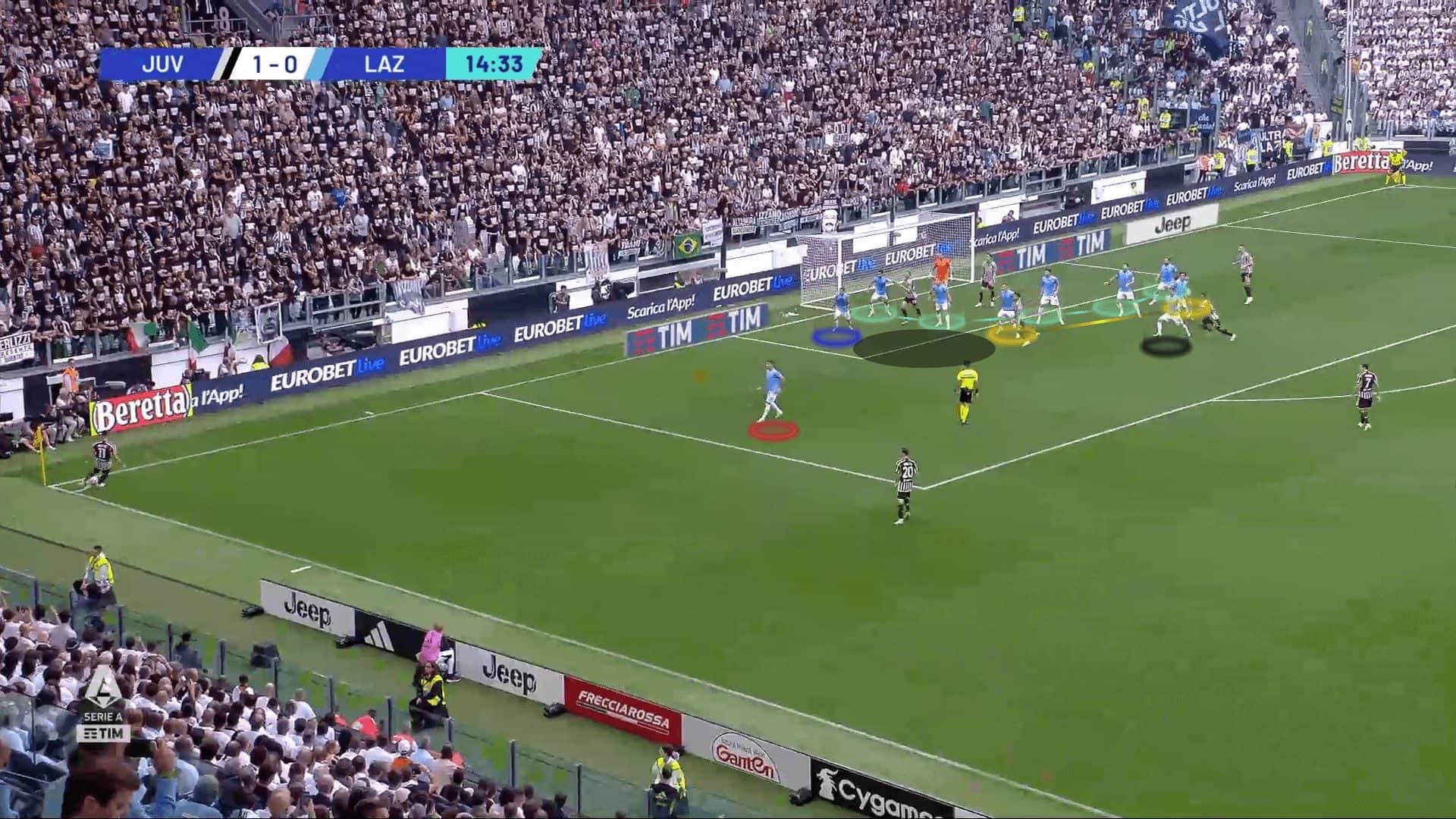
So, let’s track the near-post cross in each of them. In the photo below, the inswinging cross of the first case finds five players with small distances.
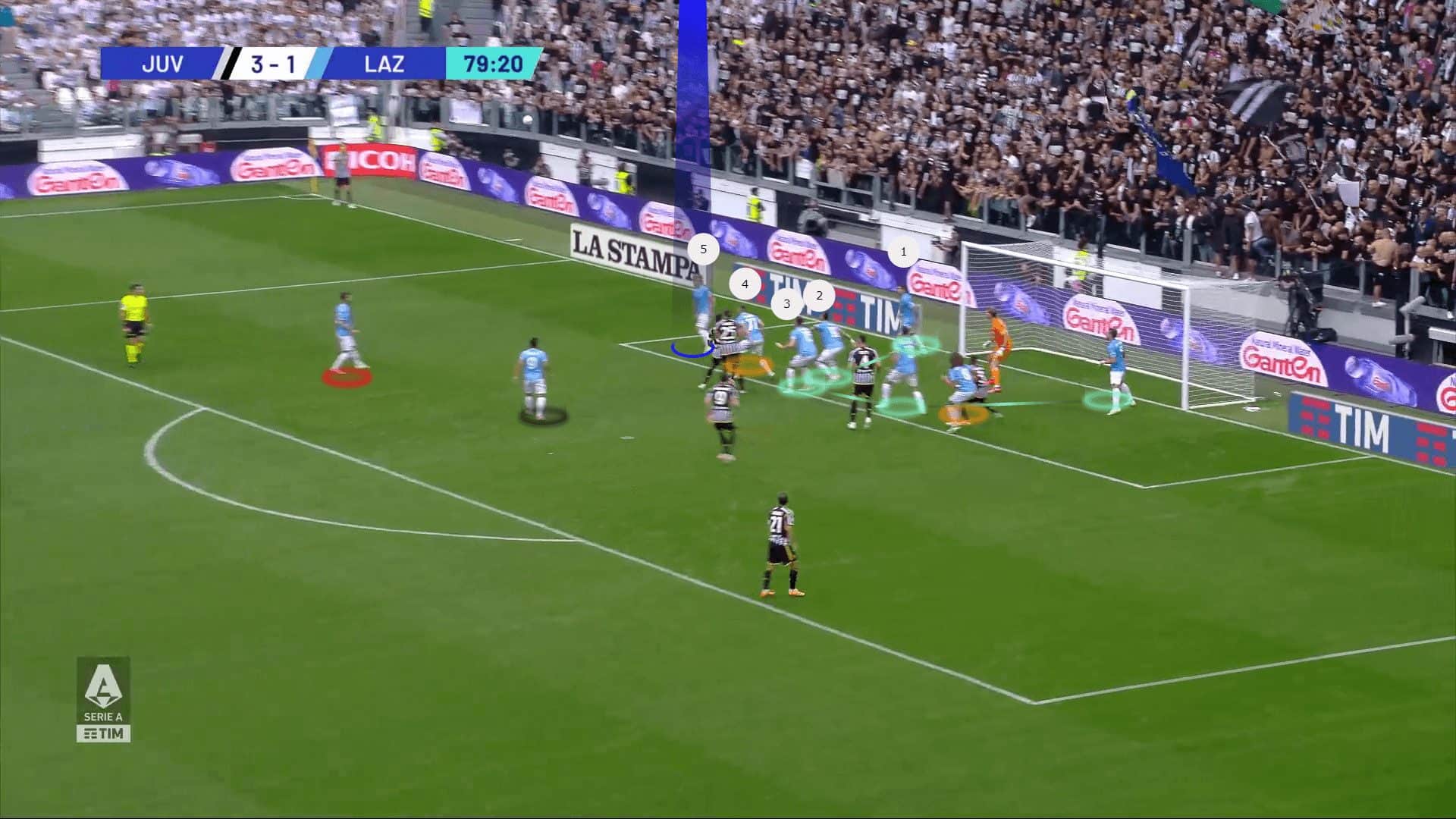
Going back to the outswinging cross of the second phase, Juventus had an idea to exploit this gap.
In the photo below, the green attacker comes to target this area from the first second-zone defender’s back with the help of the yellow attacker, who attracts the attention of the first two players in the first zonal line. At the same time, the blue attacker waits for the headed pass, or in case the goalkeeper saves it.
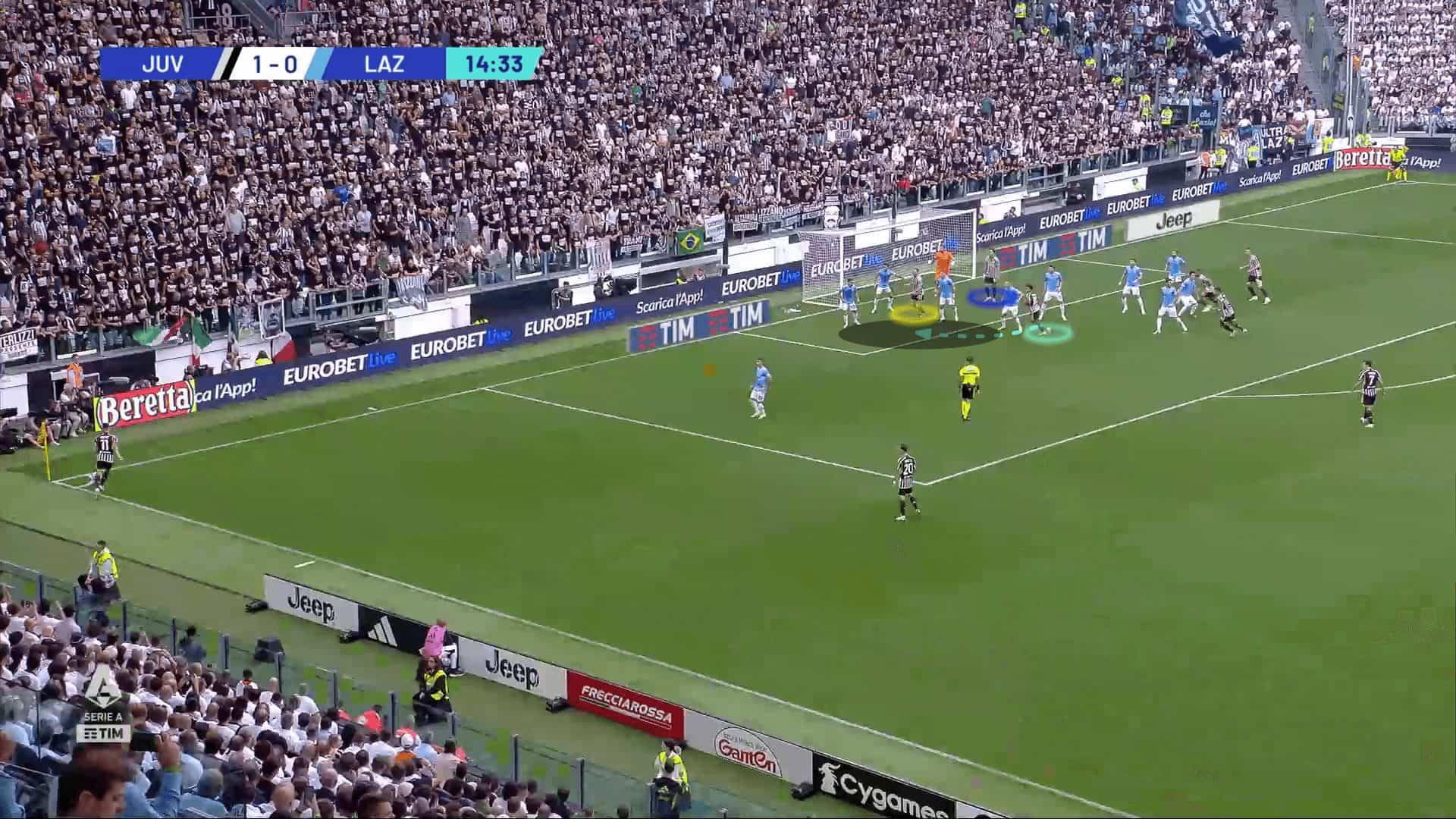
The plan works in the two photos, but the ball goes above the crossbar.
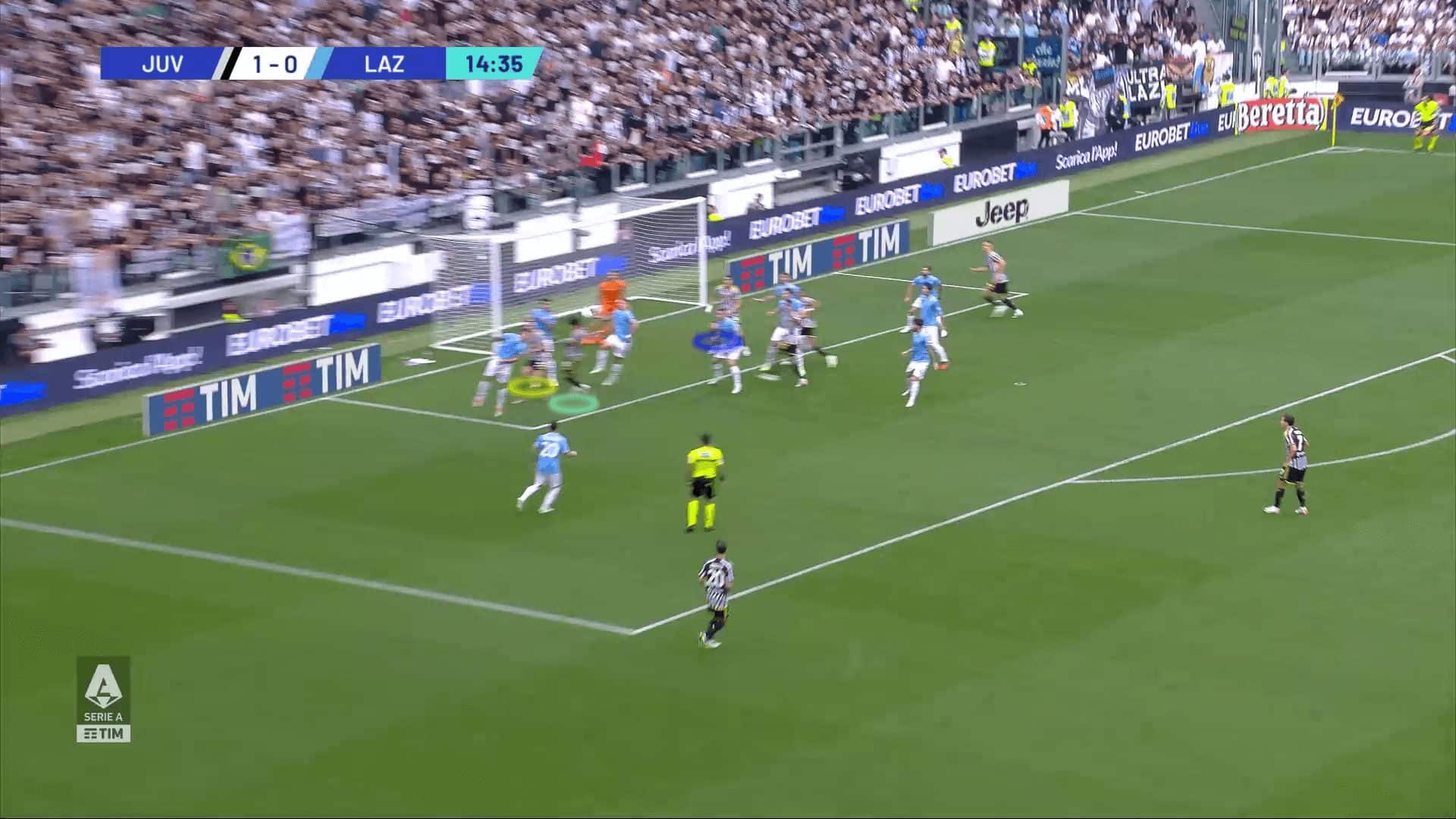
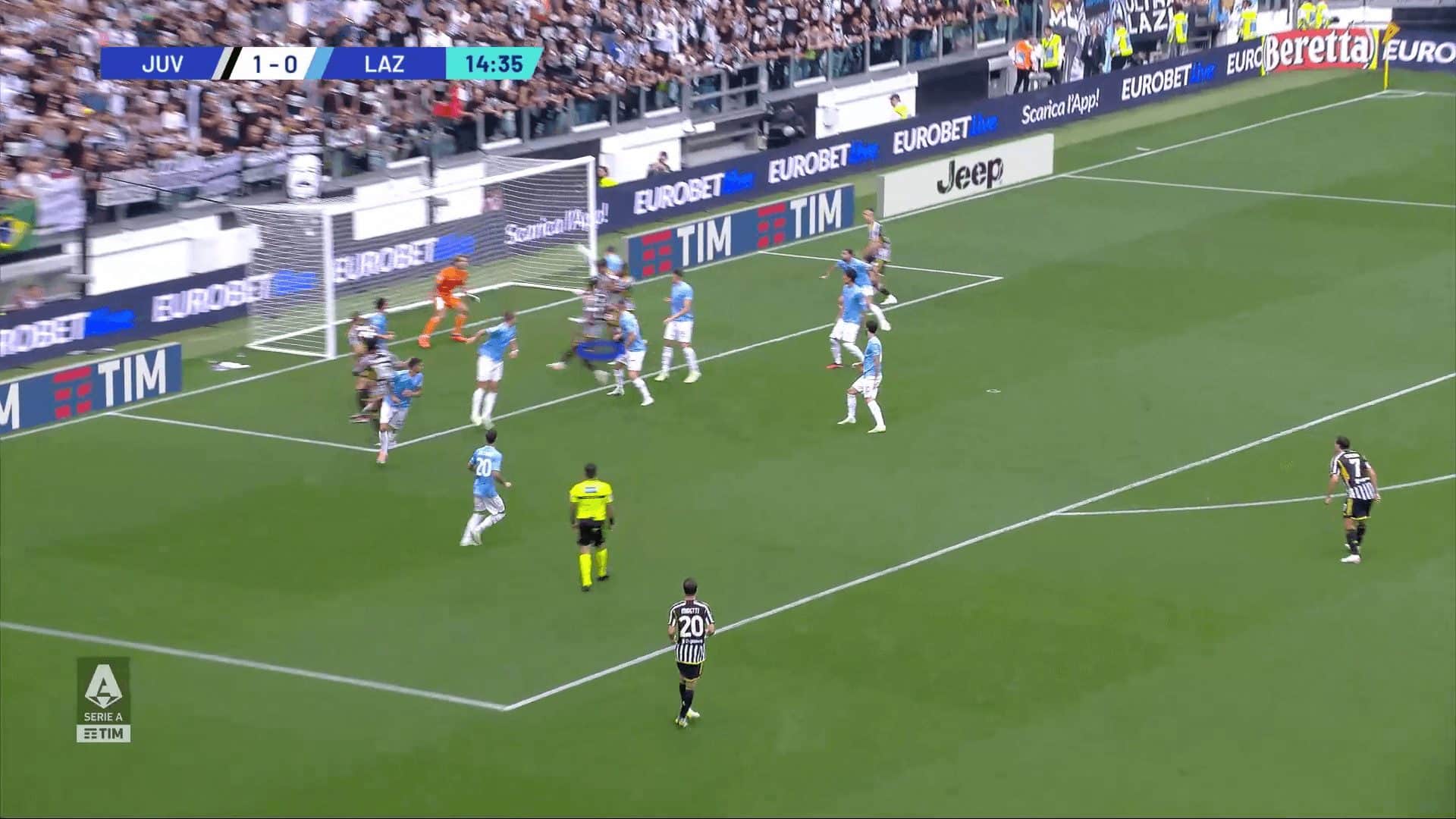
We should also mention an important note: the difficulty for the defender to track the attacker behind him and the ball simultaneously because of the path of the outswinging cross from out to in. That is called an orientation problem.
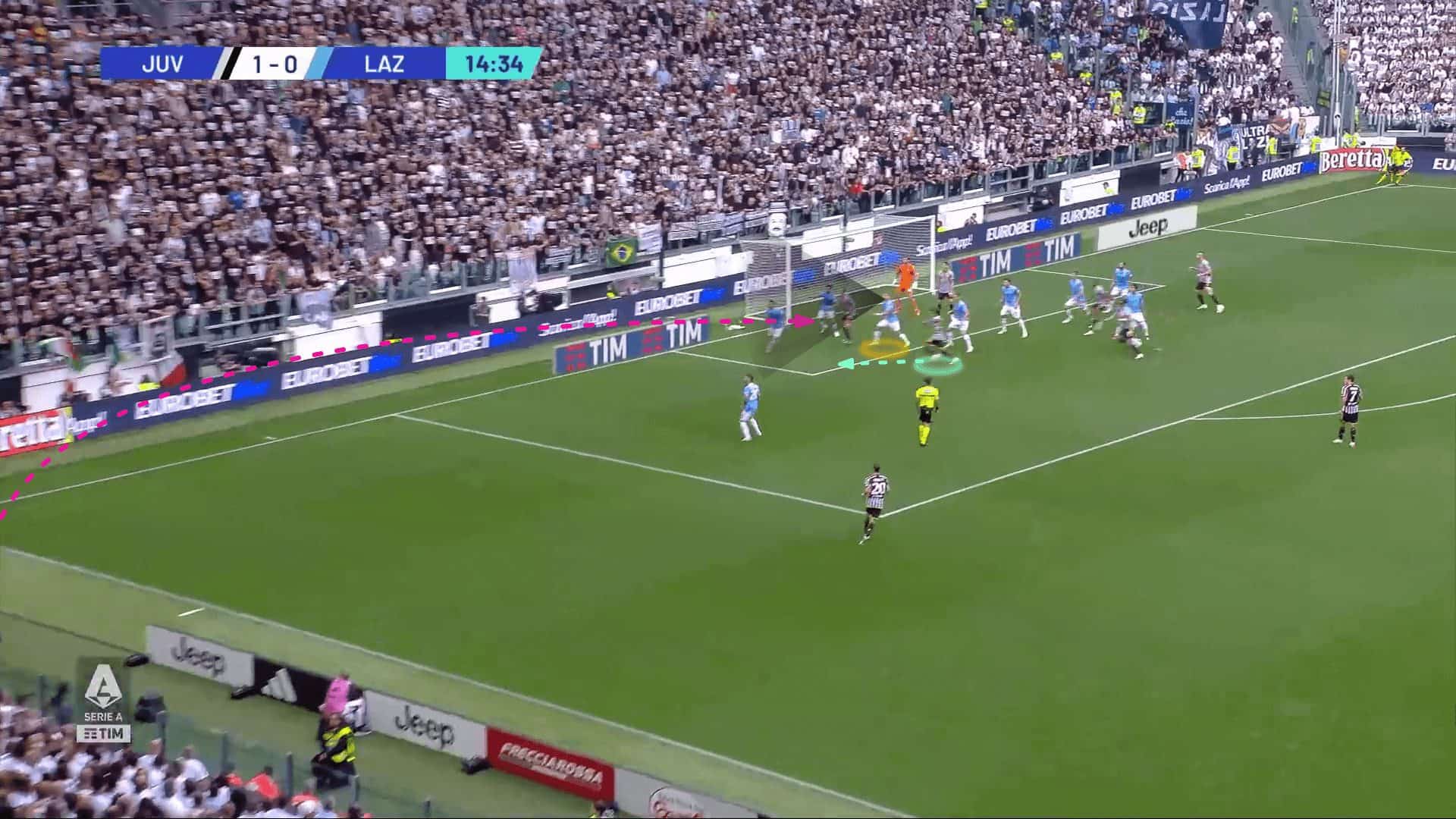
Changing Positions
The second variable we will discuss is changing some players’ positions or cancelling positions to prioritise the middle of the box and the far post.
In the photo below, we can see Sporting Cristal defend the inswinging cross against Fluminense FC by five defenders in the first zonal line, including the near pot defender, a first-touch defender in blue, a second-zone defender standing on the corner of six-yard, two man-markers and a defender for short and rebound.
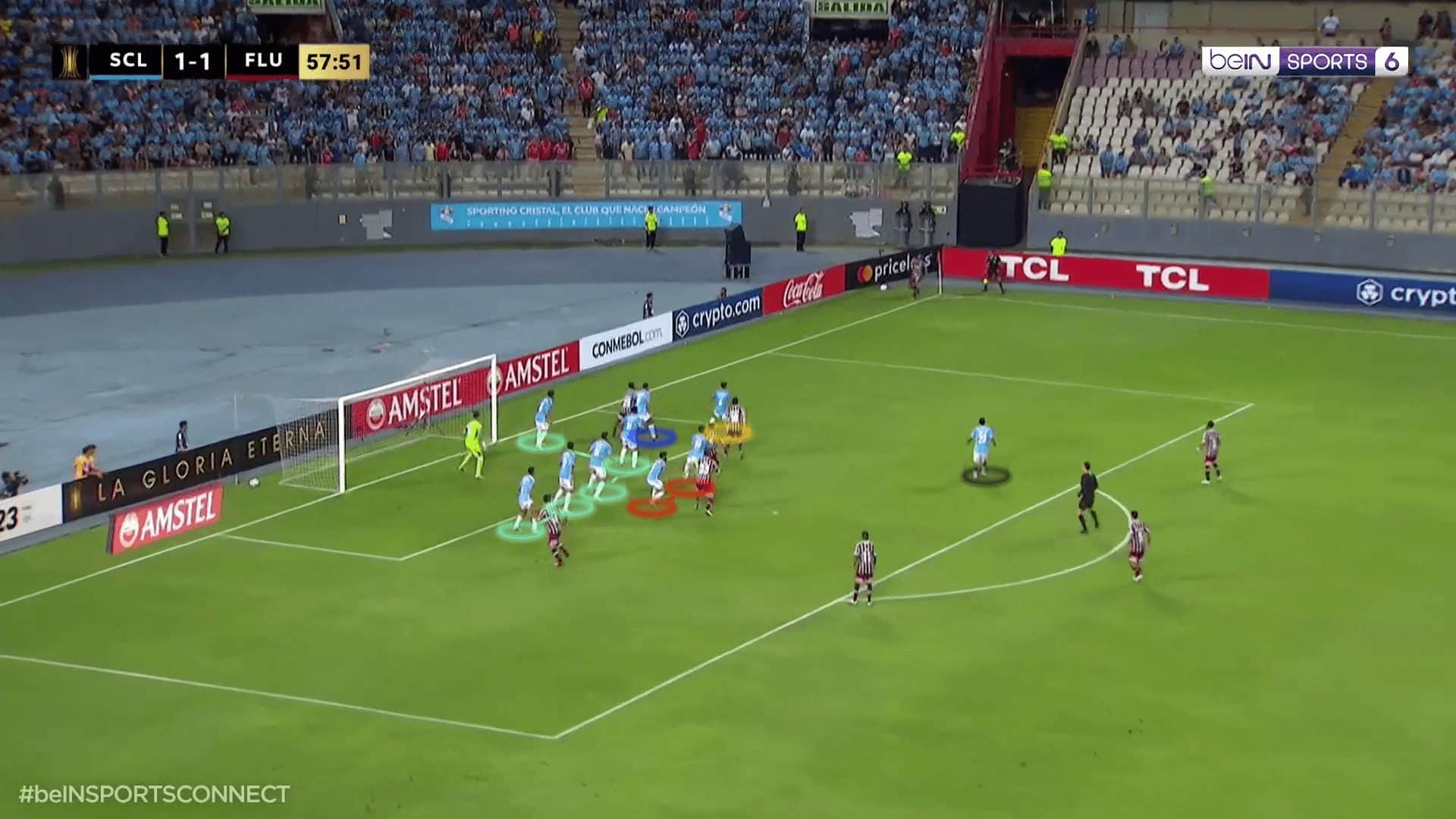
So they can easily defend the near-post cross, as shown below.
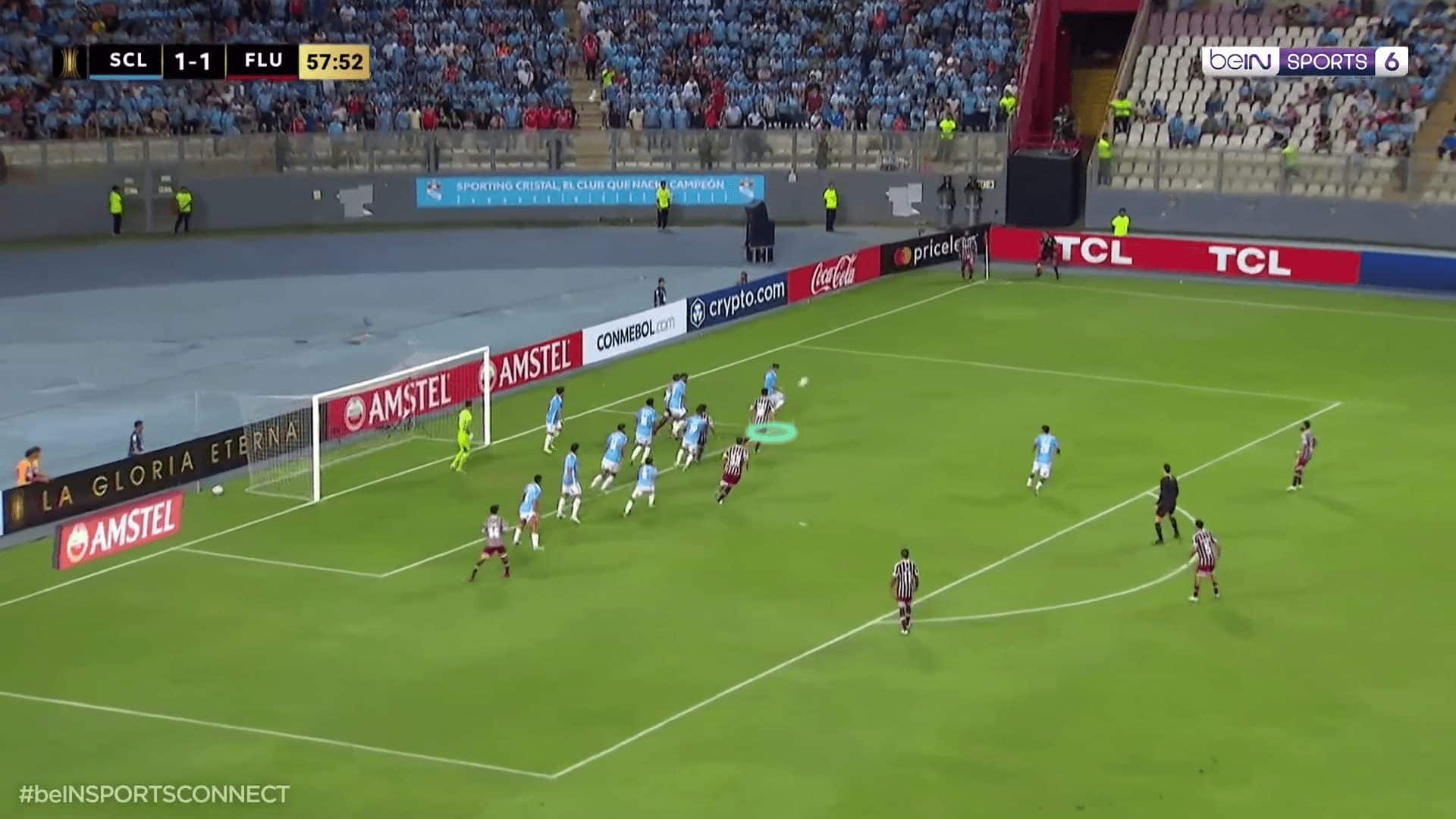
But against outswinging crosses, they cancelled the near-post defender, as shown in the first photo below, so Fluminense FC exploited that, scoring a goal.
In the second photo, the targeted player stands behind his teammate in a small stack, trying to be far away from his maker, as shown in the third photo. In the fourth photo, he targets the edge of the six-yard, while the first zonal player can’t see him because of the orientation problem.
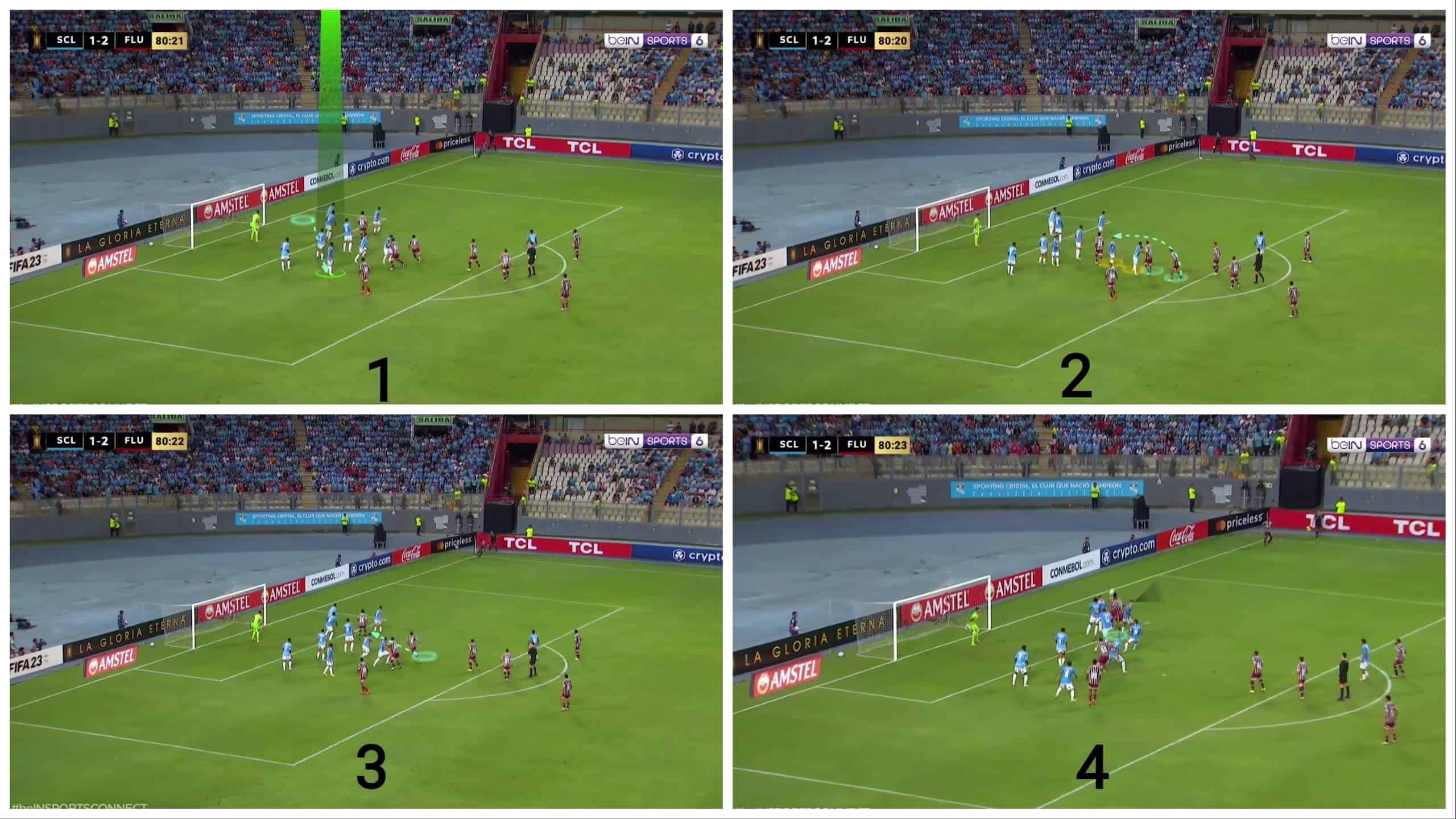
The plan works, and the result is a goal.
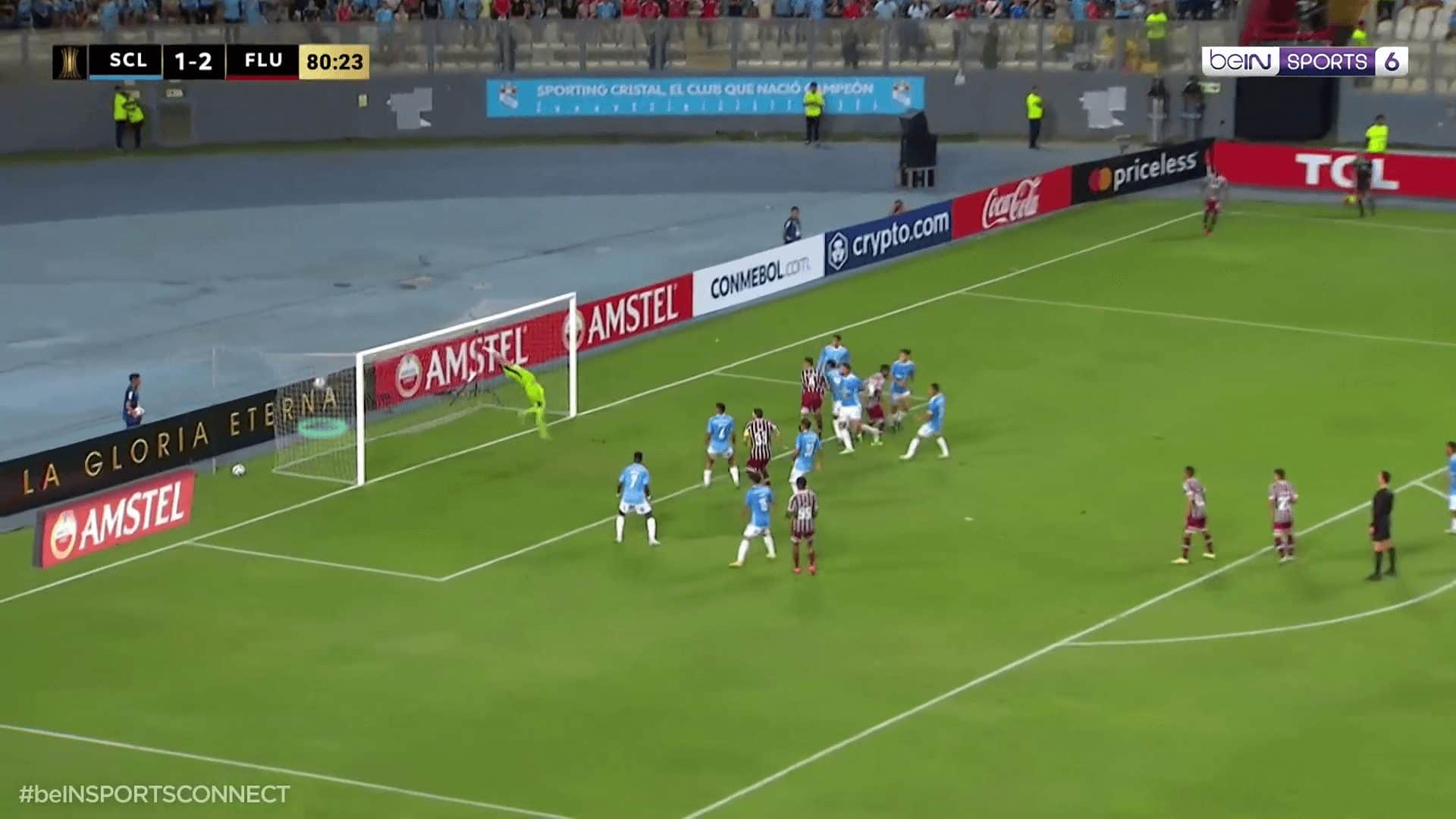
In the following case in the Egyptian Premier League, we will discuss a similar idea, but by changing the position of the first second-zone defender, as we will explain.
Against the inswinging cross, the defending team was defended by six players in the first zonal line, three in the second-zone line and a defender for the short corner and rebound.
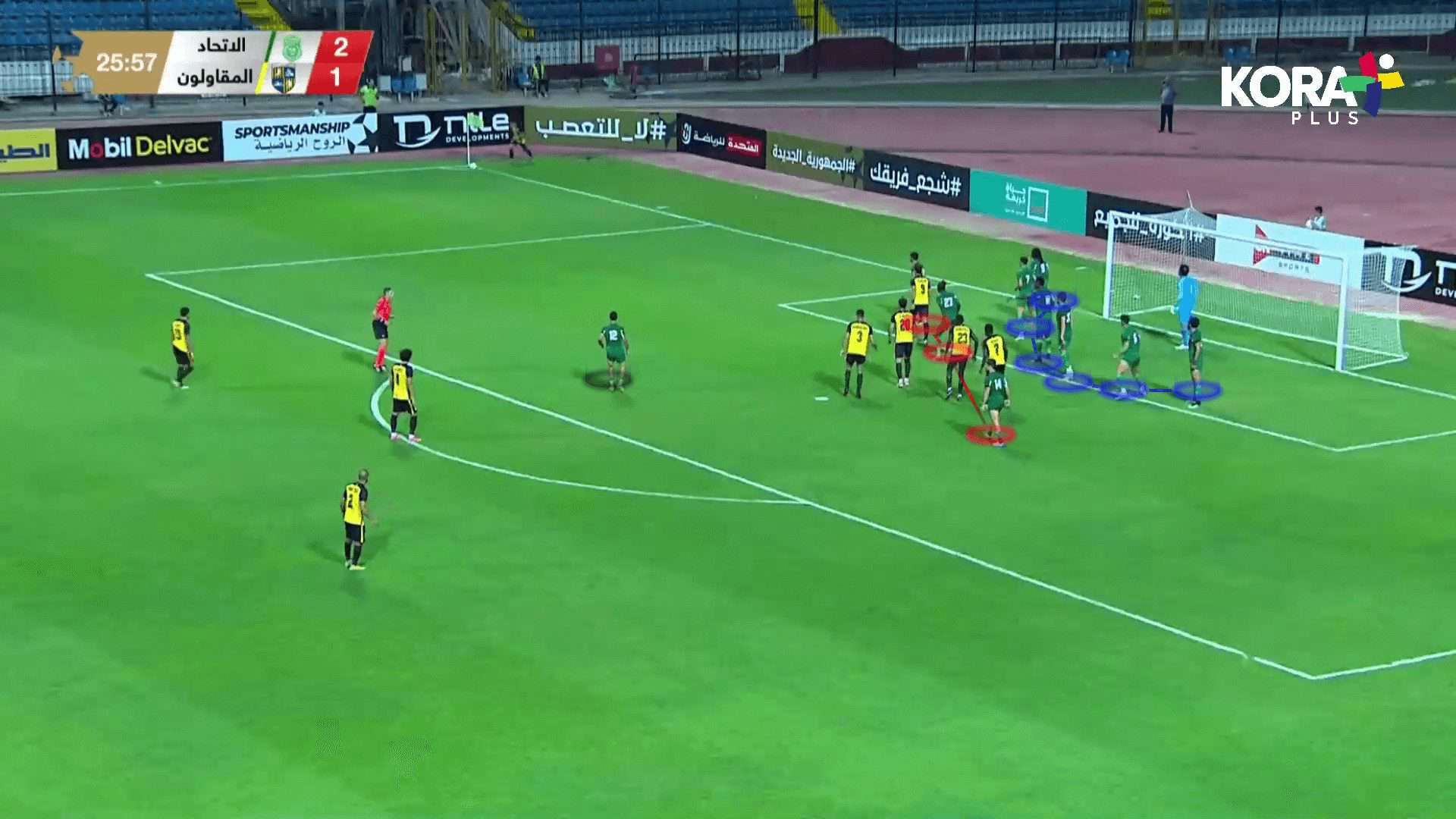
You can see below that the near post is well-defended.
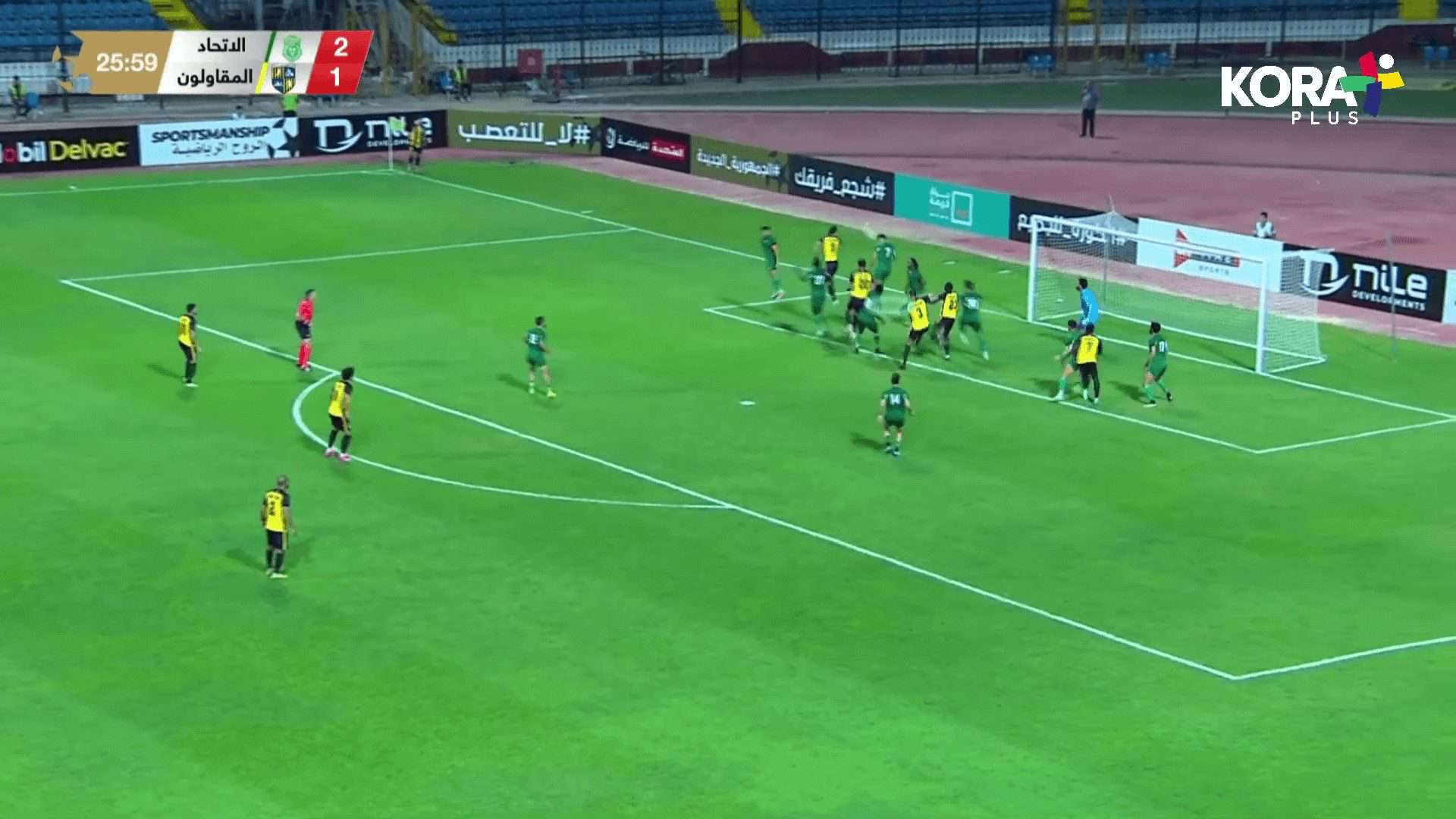
Against outswinging crosses, the same team, Al Ittihad Alexandria Club, asks the first defender in the second-zone line to move inside to shift the line more to the far post, as shown in the first photo.
In the second photo, an attacker comes from this defender’s blind side, exploiting this large area, but the ball hits the crossbar, as shown in the fourth photo.
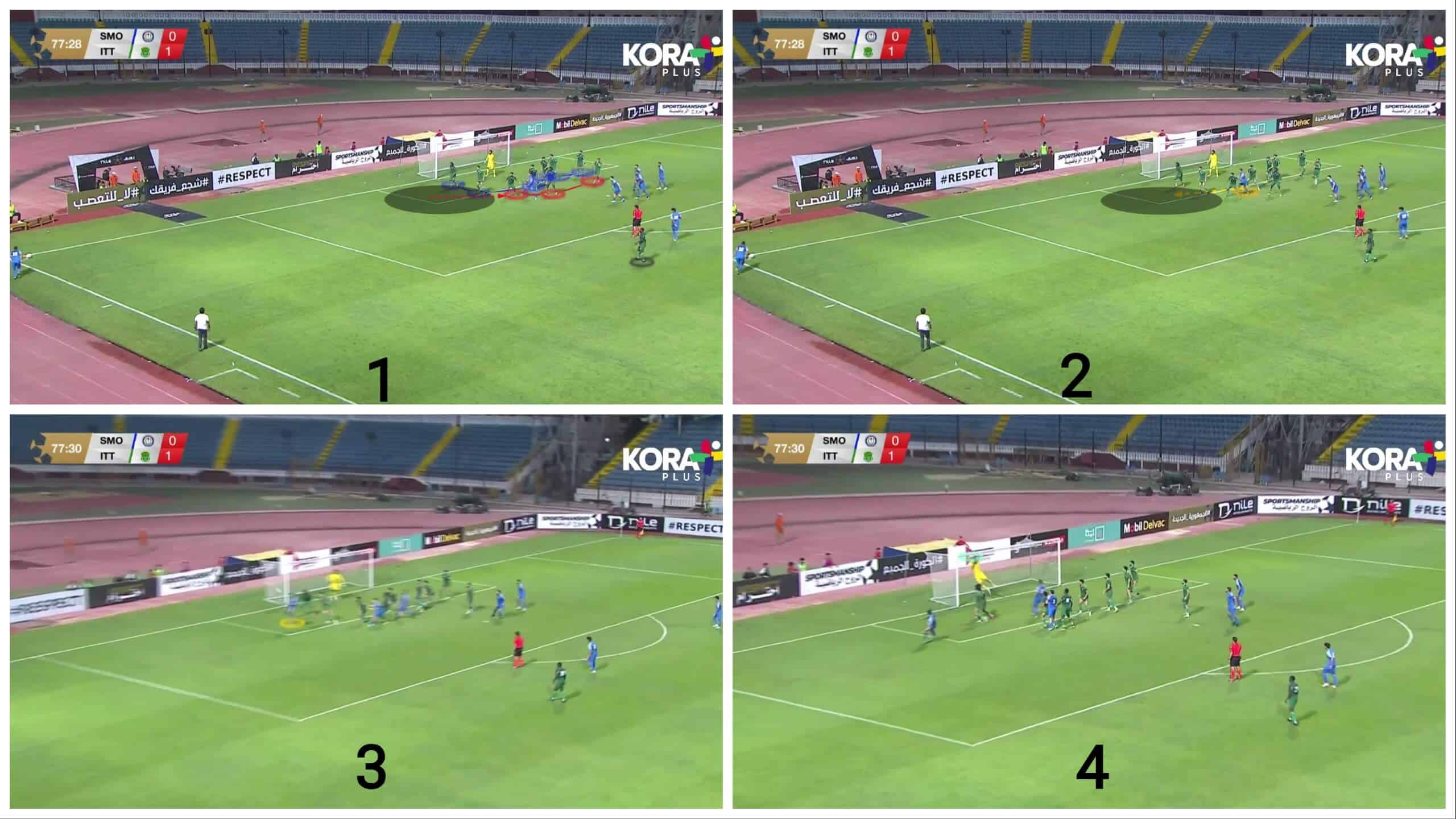
Deceptive runs
Attacking teams try to make this space more empty by dragging the near-post defender to the short area by asking an attacker to start to move from the box to drag the near-post defender who goes to helo, preventing a 2-v-1 situation, as shown in the first photo. In the second photo, Zamalek SC overloads this area with three attackers, as shown in the third photo.
In the fourth photo, the plan works, but the attacker hits the ball toward the defender’s back.
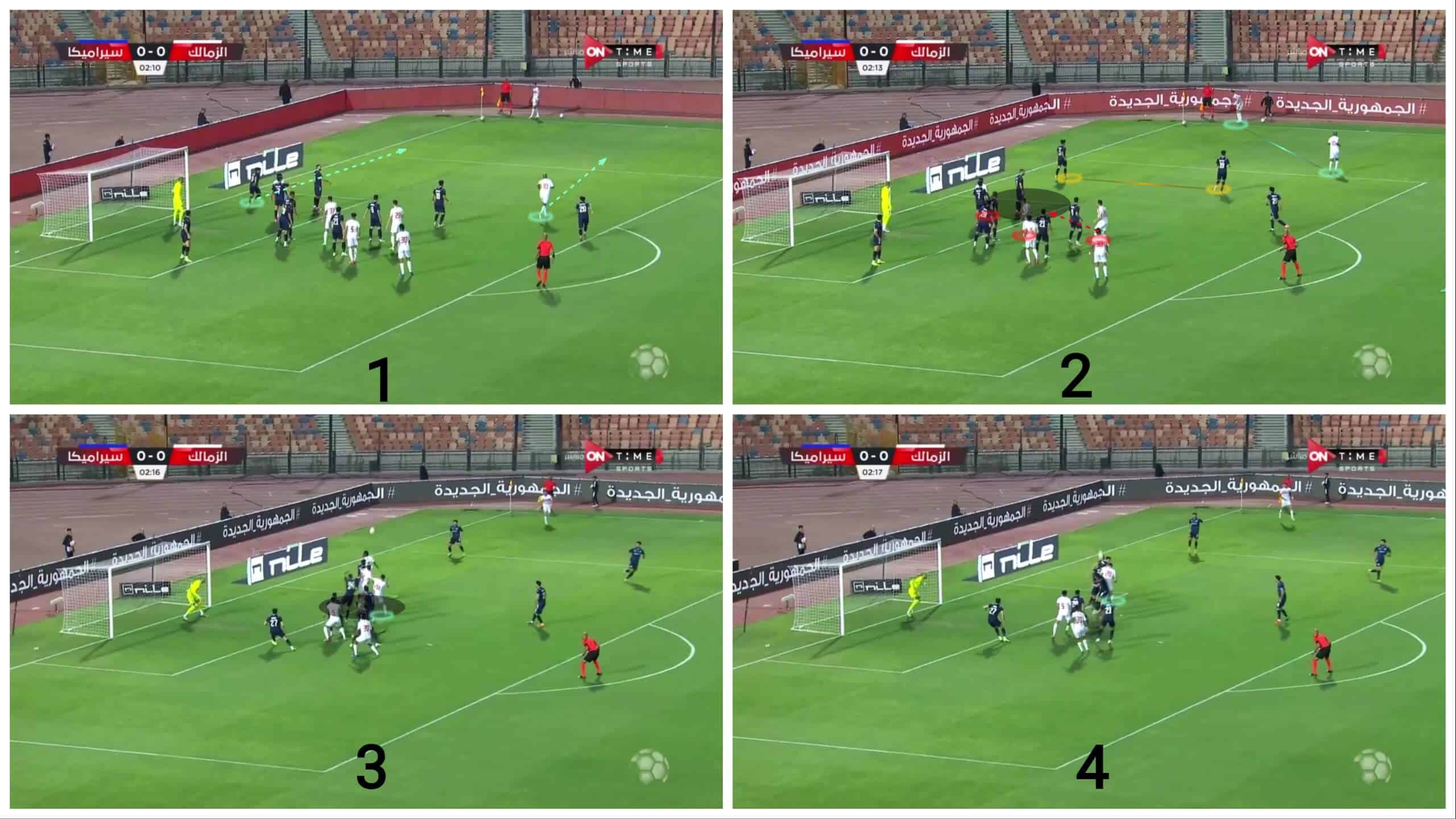
Against Man City, Chelsea scored a crucial goal by using a similar idea.
In the first photo, Chelsea starts with closer short and rebound two options, which make Man City’s rebound defender help to leave the rebound area to make sure that he won’t annoy the targeted player in red and also to motivate the first zonal defender to go out to help, as we will explain. Man City defends with five defenders in the first zonal line and three players in the second-zone line inside the box, so three players can try to protect that empty targeted area, as shown in the second photo.
In the third photo, the yellow attacker moves to drag the first zonal defender while two attackers block the second and third defenders in green.
In the fourth photo, the targeted player starts late behind his teammate, who moves toward the first second-zone defender, who can obstruct the targeted player’s path.
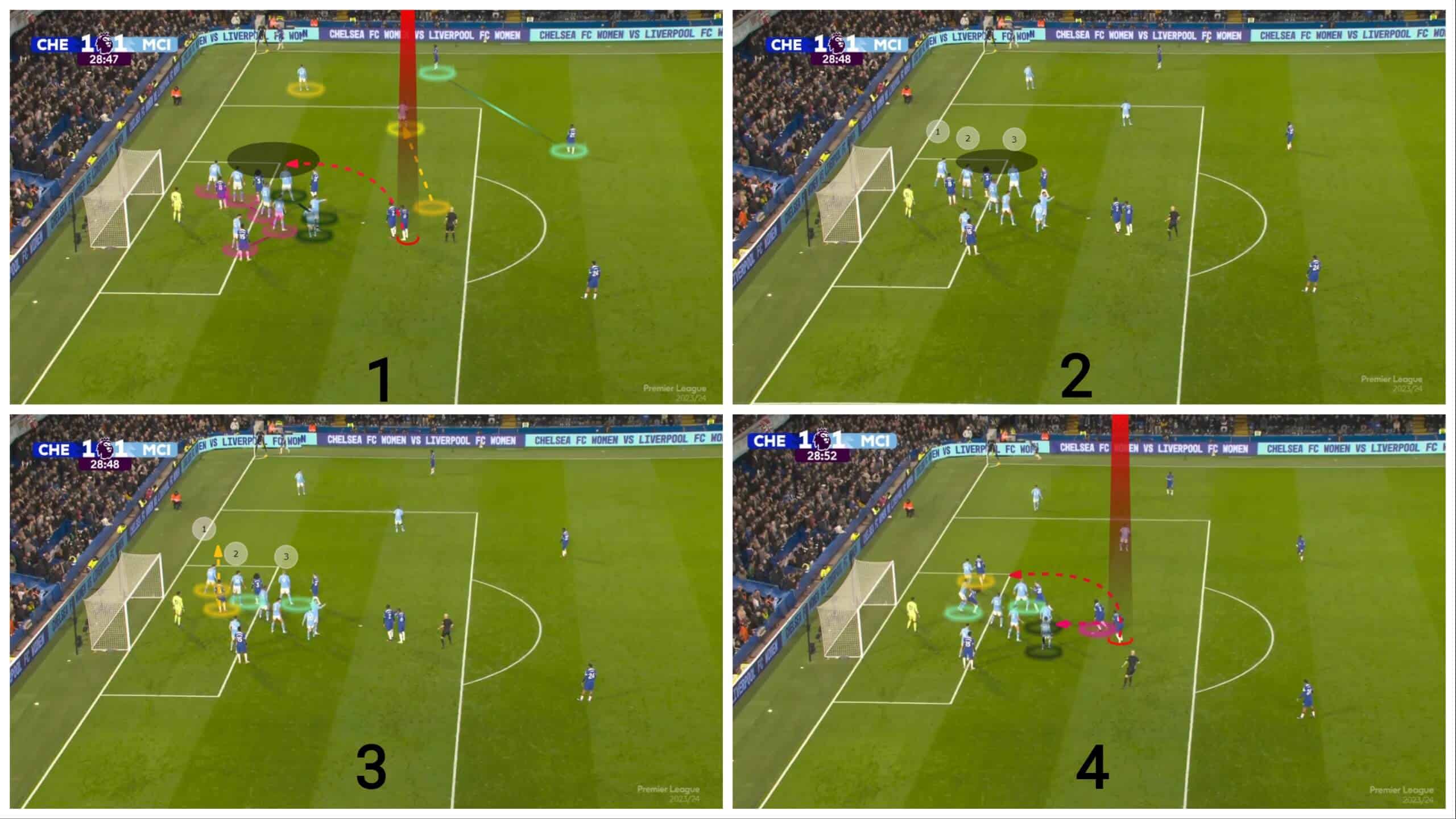
The four events are shown below.
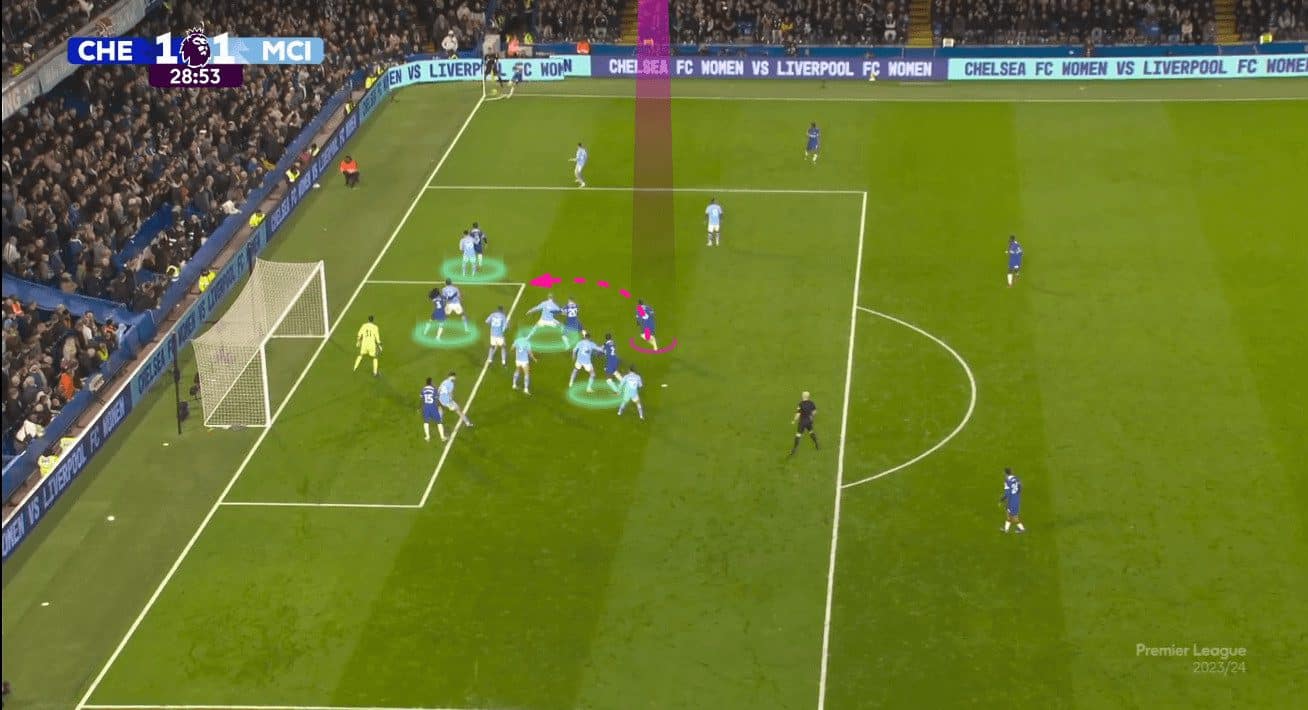
The plan works, and the result is a goal while two attackers are waiting for the rebound, or in case the headed shot isn’t accurate or the attacker can only flick the ball.
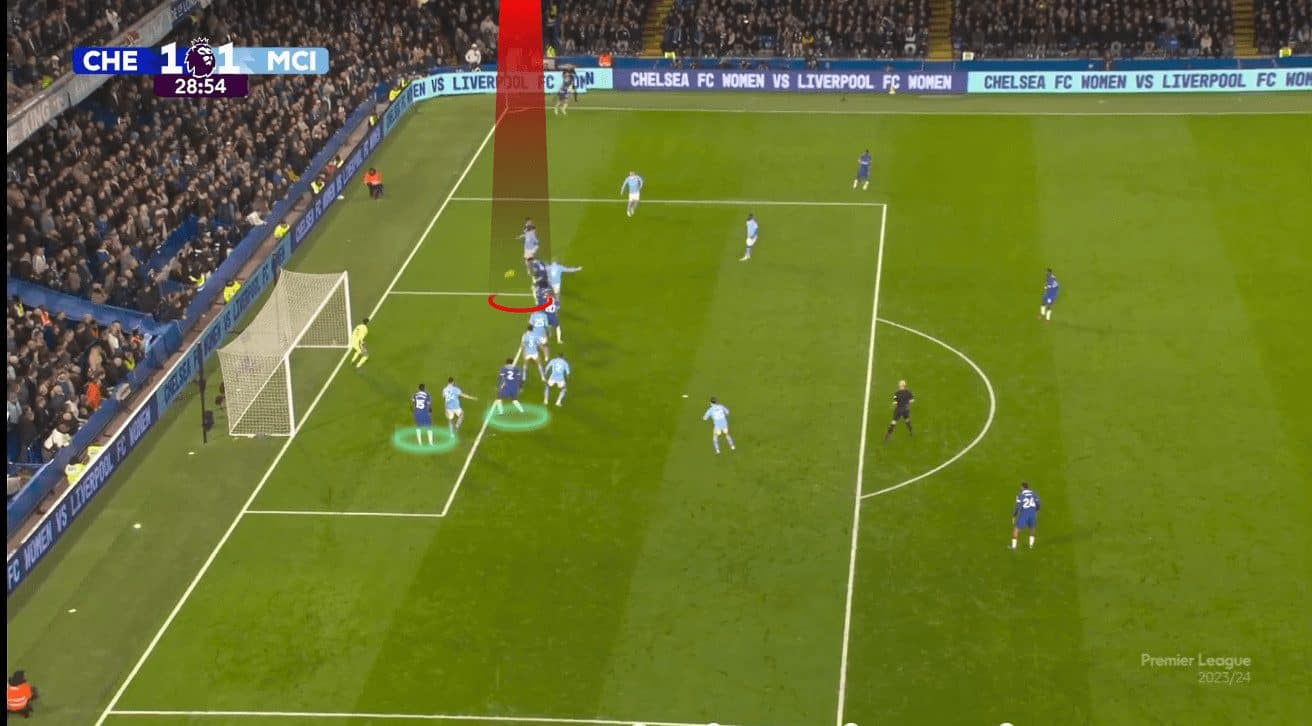
Defending idea
Of course, there are many defending counter ideas like everything in football. Still, it could be an issue of priority for most teams to defend these far areas against out-swinging crosses, especially since this technique needs a good taker who is brilliant at outswinging crosses. Still, Liverpool have a good idea for that, as we will explain below.
In the first photo, they defend the inswinging cross by five players in the first zonal line, Andrew Robertson in front of them to get the first touch and go to help against a short corner, two defenders in the second-zone line, short-area defender and rebound-area defender. In the second photo, you can note that the near-post area is well-defended.
In the third photo, they have an excellent scheme to defend outswinging crosses using the same numerical scheme, but they change some positions.
They keep using Andrew Robertson, highlighted in yellow, to get the first touch defending the area we talk about while asking the short defender to go back toward Andrew Robertson to help him while scanning his back continuously, leaving the two man-markers, in blue, to defend the middle and far areas.
We can also note that the first zonal line, highlighted in green, got more inclined outward to help more to cover the middle and far areas, so we can see that they defend well the near-post area, middle area and the far-post area.
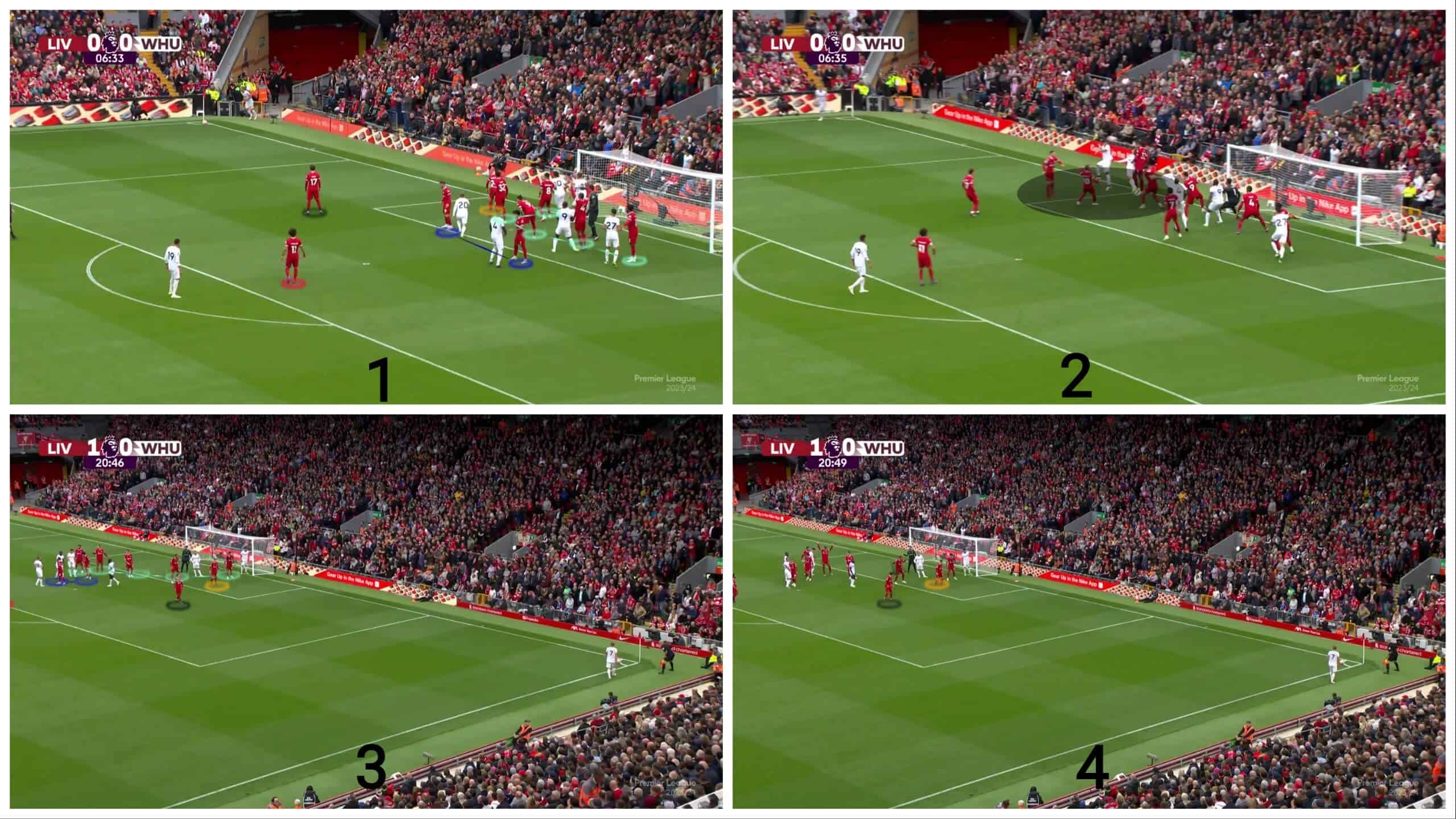
Conclusion
In this analysis, we have mentioned how outswinging corners could be surprising to the near post, although they are not expected, showing the defending gaps that attacking teams could use.
In this set-piece analysis, we have illustrated how attacking teams can exploit the large distances between the defenders on the near post aiming to cover the middle and far post. Attacking teams can also exploit fake runs to drag near-post defenders far away to decrease the number of defenders there.
We have also explained possible defensive tactics to solve this issue to defend the near-post area, the middle area and the far-post area.

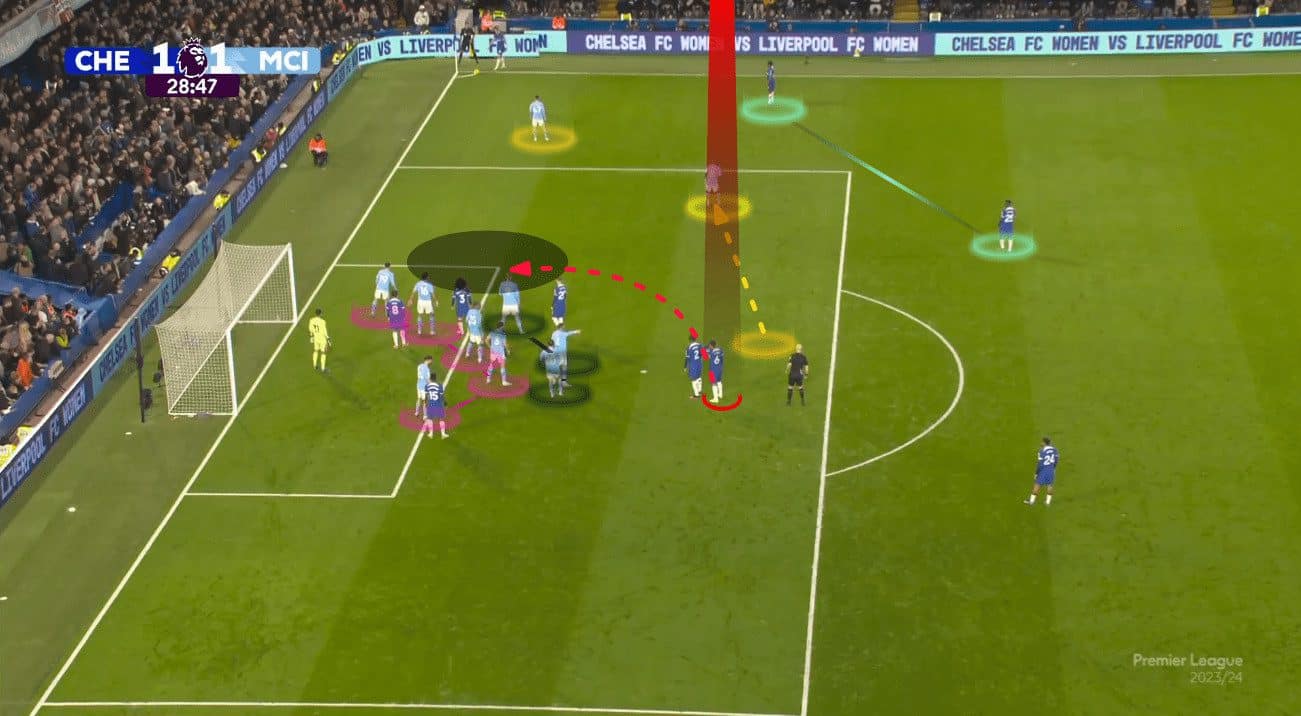




Comments